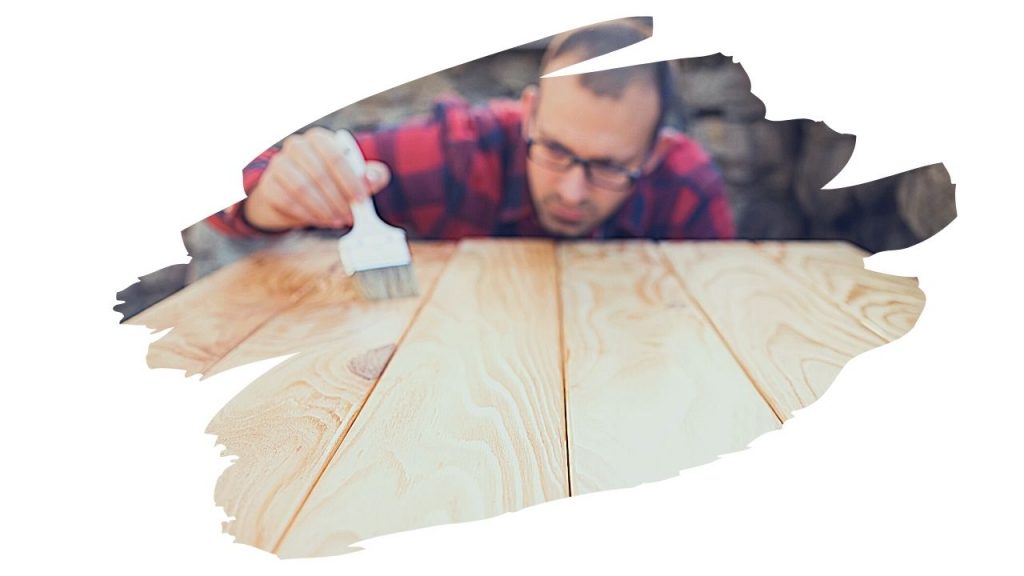It was all going so well. You poured your heart and soul into making the perfect woodwork piece. And to add a finishing touch, you layered on a protective coat (or two) of danish oil.
Now, you may have given it a few days, but that wood surface is still wet to the touch.
So why is that danish oil finish not drying?
When danish oil doesn’t dry properly, it is usually because the oil itself was old or poorly stored.
Another cause is the over application of danish oil between coats. If the oil finish isn’t drying, it is probably because excess oil wasn’t properly wiped off after each coat.
Still, don’t throw in the towel just yet. Non-drying danish oil is far from a disaster. In fact, there are a few solutions you can try to set things right, and get your woodwork project back on track.

This post may contain affiliate links to products that we receive a commission for (at no additional cost to you). Learn more here.
How Long Does It Take For Danish Oil To Dry?
In a well ventilated area, this oil finish takes around 24 to 48 hours to dry onto the surface of the wood. But, it can take up to 30 days for it to cure and dry underneath the surface and deep into the wood fiber.
However, in humid weather, it will take longer for danish oil to cure. Correspondingly, if the weather is very hot, then it can take less time for it to completely dry.
This all depends, of course, on you having wiped all excess danish oil from the wood surface.
So, if you want danish oil to dry sooner rather than later, you should let it sit and soak into the wood for about 30 minutes. And then afterward, use a clean cloth to wipe off any surplus oil.
Related Post: This Is Why You Don’t Use Danish Oil On Poplar Wood (Revealed!)
Why Does Danish Oil Stay Sticky?
Other than not giving the oil enough time to dry, there are typically 3 main reasons why danish oil will feel sticky:
No. 1 The Oil Has Gone Off
An opened can of danish oil – especially one that has been stored for a good long while – can become treacly and congealed.
The shelf life of a can of an unopened oil-based danish oil stain is around 2 to 3 years. Once you open that can, provided that you keep it well sealed, then it can last about 1 year.
But, if you don’t seal the can up tight, then it will have a very short shelf life indeed.
You see if the oil is old and off – and you apply it to wood anyway – then this finish will become congealed and tacky underneath the surface.
In other words, whilst the surface of the wood finish will look fine, underneath the surface the oil won’t have properly cured into the timber. And that can cause problems, such as wood rot, later on.
No. 2 The Oil Hasn’t Cured
Although danish oil takes a couple of days to dry, it can take up to a month to fully cure.
Now, the difference between an oil ‘curing’ and oil ‘drying’ boils down to its chemistry;
When Oil Drys we are referring to Evaporation: This is when the solvent in danish oil evaporates, causing the oil to go from being a liquid coat into a solid film coat.
When Oil Cures we are referring to a Chemical Reaction: This is when a chemical reaction occurs in the danish oil solvent that causes the now solid film coat to strengthen and become resistant to abrasions.
No. 3 The Excess Oil Wasn’t Wiped Off Between Coats
When applying danish oil – or indeed any oil finish – you need to wipe off any excess oil in between coats.
You see, danish oil is a blend of both varnish and danish oil. This mix of two solutions means that this oil finish can safeguard your woodwork piece in two ways; (i) by soaking into the wood grain and, (ii) by coating the wood with a protective film.
The protective-soaking quality of danish oil means that you need to apply thick coats of the oil in order for it to seep fully into wood pores.
But applying thick coats also means that there is usually a fair bit of excess oil left over.
So you need to make sure that, (after you give the oil a good 30 minutes to soak in), you wipe down the surface of the wood between coats.
Related Post: What You Need To Know About Danish Oil vs Tru Oil
Help! I Forgot To Wipe Off The Excess Danish Oil!
Okay, well, first of all… don’t panic! There are a few things you can do to fix things;
A. If The Danish Oil Is Still Sticky (And Not Dry Yet)
- Wipe It Off With Mineral Spirits
If the oil still feels sticky, then you can simply wipe it right off.
Let the danish oil dry for a few more days (up to a week), and then apply a thin coat of mineral oil all over the wood surface.
The job of the mineral spirits is to try and thin the danish oil coat out a bit.
Between mineral spirits, and a lightly damp but clean cotton cloth, you should be able to wipe off most of the oil.
B. Is The Danish Oil Already Dry?
- Strip Off The Oil
This is more of a last gasp option. Why? Well, whilst this method will remove surface oil, it won’t remove any of the oil that has already soaked into the wood pores.
However, if the finish is fully cured, then you can use stripper to remove the finish from the wood piece.
This is a time-vampire of a job, plus you need to make sure you are in a well-ventilated room as you work.
- Sand Off The Oil
An alternative to applying a stripper solution is to simply sand off the cured danish oil.
You can use sandpaper to manually work over the surface, or use an orbital sander to help make quick work of things.
Either one will be your best shot at getting all the way back down to bare wood.
But, it is worth noting that this will only take off the surface oil. Any oil that has soaked and cured into the wood is pretty much staying right where it is – regardless of how much you sand.
How Can I Make Danish Oil Dry Faster?
There are a few easy tricks you can try to make it dry faster. Although, it is worth noting, none of these tricks will make it cure more quickly. Curing will simply take as long as it takes.
Tip 1. Use An Oscillating Desk Fan
Blowing air onto the oil finish can speed up the drying process.
You need to be a little bit cautious with using this quick-drying method.
It seems like a complete no-brainer to simply use a fan to quick-dry that finish. However, all of the air movement caused by that oscillating fan can kick up dust particles all over the workshop.
And the last thing you want landing on a still-wet oil finish is dust and dirt.
Tip 2. Use A Dehumidifier
If you live in an area that has its fair share of humid weather, then a dehumidifier could come in handy.
Place the dehumidifier near your danish oil coated wood project so that it lowers the humidity in the room.
Tip 3. Turn Up The Heat
Increase the temperature in the room. A warmer room will help speed up the drying process.
How Can You Tell If Danish Oil Is Dry? Well, this is when we use a simple ‘touch-and-go’ method. If the coat of oil is dry to the touch, it is ready to go! Just run your fingers over the surface. If you leave a smudge behind on the surface, then the oil isn’t dry yet.
So, How Do You Keep Danish Oil From Getting Sticky?
Its pretty simple really. As you apply the oil finish, just make sure that you;
- Use Danish Oil That Isn’t Old Or Off
And make sure you store the oil in a well-sealed container.
- Wipe Excess Oil Between Coats
Use a clean cloth to get rid of surplus oil. And double check that the oil is dry and evenly layered before you go adding another coat.
- Let Each Layer Dry Between Coats
You’ll want to give each coat some 4 to 8 hours to dry. And, ideally, let the wood piece dry in a well-aired humidity-free area.
- Let The Final Finishing Coat Fully Cure
Set it aside so that you can give the surface oil 1 to 2 days to dry. But know that the oil seeped into the wood under-the-surface will take up to a month to cure.
References
https://heightslibrary.org/materials/hrrc/04-Home_Maintenance/DISCARDING_MATERIALS.pdf



